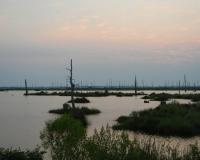
Vibrant Environment
Oceans And Coasts
All | Biodiversity | Climate Change and Sustainability | Environmental Justice | Governance and Rule of Law | Land Use and Natural Resources | Oceans and Coasts | Pollution Control
Charting the Course: A Survey on Public Engagement in the Natural Resource Damage Assessment Process

Public participation and engagement are easy values to talk about generally, but are difficult to implement meaningfully. In Gulf restoration, the natural resource damage assessment (NRDA) process provides the federal government, states, and the public with an unprecedented opportunity to pursue the difficult actions that put these values into practice.

The Great Pacific Garbage Patch, a collection of marine debris swirling around the north Pacific Ocean, is estimated by some scientists to be roughly the same size as the state of Texas. While the Garbage Patch moniker can conjure images of a physical trash island, in reality, it is almost entirely made up of microplastics not always seen by the eye, turning the sea into a cloudy soup. Around 80% of the debris comes from land-based sources in North America and Asia.

The legislative process is complicated. Sea-level rise adaptation is complicated. Combine the two, and a tangled mess can result as the law sorts itself out.
Few laws on the books were written with sea-level rise (or climate change, generally) in mind. As a result, policymakers, lawyers, and property owners are left to their own devices to determine how it all fits together. This round hole-square peg legal setup often requires judicial adjudication to become workable and uniform.
At the national level, the regulation of greenhouse gases under the Clean Air Act is a great example.

At the 2016 Our Ocean Conference, nearly 20 countries announced the creation of new Marine Protected Areas (MPAs) or the expansion of existing ones. This is an important step in the right direction, but creating new MPAs will not make a significant difference if new and old MPAs are not effectively enforced. Through the release of its report, Legal Tools for Strengthening Marine Protected Area Enforcement: A Handbook for Developing Nations, the Environmental Law Institute’s (ELI’s) Ocean Program is playing its part to assist countries in ensuring that MPAs are effectively implemented and enforced, delivering positive conservation outcomes.

On August 23, 2016, the Gulf Coast Ecosystem Restoration Council (Council) released its draft Comprehensive Plan Update. This plan “is intended to provide strategic guidance” to the Council in order to “improve Council decisions…” No projects or programs are proposed in the plan. The public has until October 7, 2016 to comment on the plan. If the plan is approved, it will “supersede[] the Initial Plan approved by the Council in August 2013.”
This post highlights some of the key features of the plan, including where it fits into Gulf restoration, what’s in the plan, and what questions remain.

This past January, NOAA released a landmark final rule (referred to here as the Gulf Plan) establishing a permitting and regulatory framework for offshore aquaculture—fish farming—in federal waters in the Gulf of Mexico. Since the Gulf Plan is the first rule to enable aquaculture in federal waters (3-200 miles offshore), the environmental and economic outcomes are uncertain. This ruling—the product of over a decade of research and revision—has become the subject of intense criticism from both environmental organizations and proponents of offshore aquaculture. NOAA lauds the ruling as a long-overdue policy to create economic growth and meet demands for sustainable seafood. At the same time, some environmentalists predict increased pollution and fish disease, fishermen fear price drops, and potential investors think the regulation is overly complex.

It all starts as mountain rock.
That rock erodes from wind and rain and time, getting transported down rivers all the way to the sea, where it accretes onto beaches and into other sediments. That is the origin story of sand. Once that sand is on a beach, or off the coast, or on an inland shore, it is transported through a natural cycle that replenishes the resource over geologic time.
Or rather, that is the way it is supposed to work.

Note: This blog was cross-posted from ELI's Gulf-specific website, where you can find information on everything you need to know about Gulf restoration.
In June, the ELI Gulf Team released a survey on priorities for Gulf restoration in the wake of the Deepwater Horizon oil spill. It was designed to understand what elements our partners and collaborators think are most important to good restoration projects. We started with a list of eight project elements:

Climate change and sea-level rise are reshaping the coastline along the Gulf of Mexico. Land is being lost at an alarming rate, especially in Louisiana, where subsidence is compounding the effects of sea-level rise. Across the Gulf Coast, communities are increasingly vulnerable as the seas rise, land subsides, saltwater intrudes, and marshes retreat. In the face of such monumental change, it is essential for communities to plan and adapt.

The 2016 Resumed Review Conference relating to the Conservation and Management of Straddling Fish Stocks and Highly Migratory Fish Stocks (UNFSA) took place at U.N. Headquarters in Manhattan from May 23-27, 2016. The outcome document serves as an example of the challenges and limitations of international ocean governance.
In the years since the 2010 Resumed Review Conference, there has been positive news in the field of international conservation of the marine environment. Chile, Palau, and the United States have created new Marine Protected Areas (MPAs) in their Exclusive Economic Zones. In early 2015, representatives of 104 nations began drafting a legally enforceable international treaty, which is still under negotiation, for the protection of biodiverse areas beyond national jurisdiction (ABNJ). The treaty would limit unregulated activities on the High Seas and lead to the creation of a global MPA network.